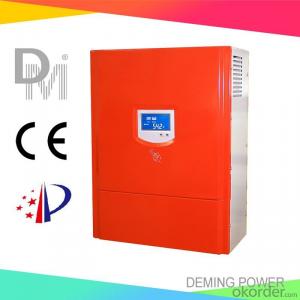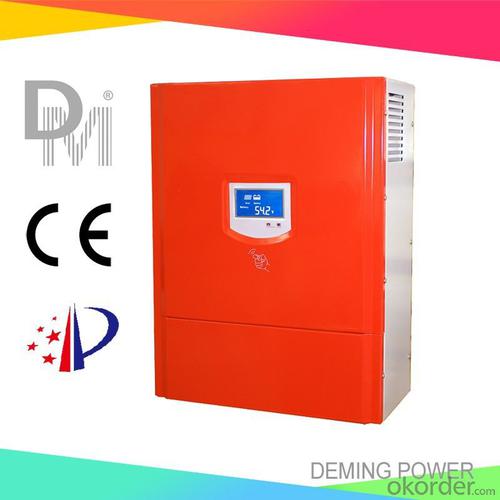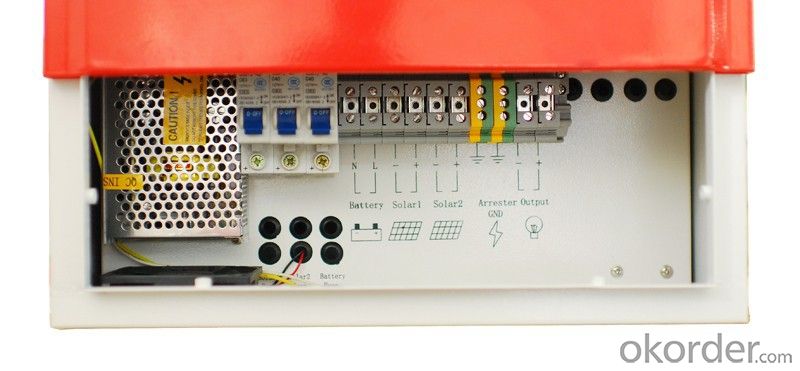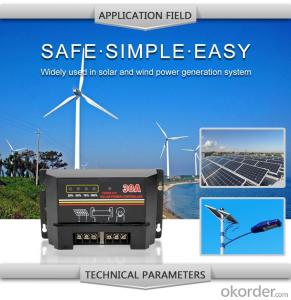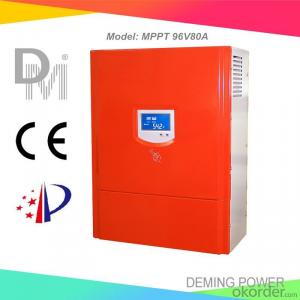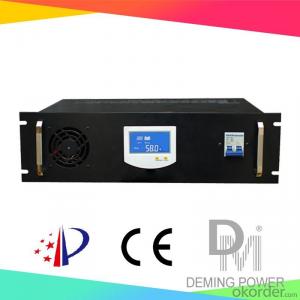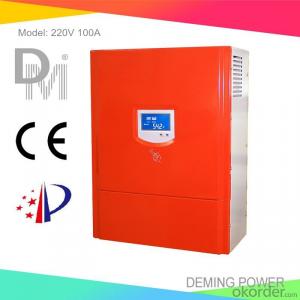Solar Panels and Controllers:MPPT Solar Charge Controller 96V 100A with Best Price for Solar Power System
- Loading Port:
- Qingdao
- Payment Terms:
- TT OR LC
- Min Order Qty:
- 1 PCS
- Supply Capability:
- 1000 PCS/month
OKorder Service Pledge
OKorder Financial Service
You Might Also Like
Properties of the solar charge controller
1. Design for off-grid solar power system.
2. Applicable to different kinds of batteries.
3. Adopts MPPT technology (Maximum Power Point Tracking). The advanced tracking algorithm make the solar module operate at ideal voltage which the solar modules can produce the maximum available power.
4. Modular design with simple structure and easy maintenance.
5. Automatic power control function.
6. LCD display: Solar panel current, solar panel voltage, solar panel power, battery group voltage, charge current.
7. Perfect protection function: Solar reverse charge protection, Solar reverse connection protection, Battery reverse connection protection, Battery overcharge protection, Battery over current protection etc ,thus the system has higher reliability.
Technical parameters of the solar charge controller
Model | 96V100A | |||||
Battery group rated voltage | 96Vdc | |||||
PV Rated current | 100A | |||||
PV open circuit voltage | 400V | |||||
PV Max. power | 9600Wp | |||||
Input PV module road number | 1 | |||||
Function | MPPT charge mode, auto stop charge, auto recharge voltage; Protection: connecting contrary, over current, short circuit, over heat etc. | |||||
Display mode | LCD | |||||
Display content | solar panel voltage, solar panel current, solar panel power, battery voltage, charge current | |||||
MPPT DC voltage range | 80-116Vdc | |||||
Floating Charge Voltage (adjustable) | 110Vdc | |||||
Stop charge voltage | 116Vdc±1% | |||||
Recharge voltage | 108V±1% | |||||
Voltage drop between PV and battery | 1.5V | |||||
Max itself power consumption | 100mA-150mA | |||||
Work environment temperature | -30-60°C | |||||
Relative humidity | 90% No condensation | |||||
Applicable altitude | 3000m The rated power should be reduced when it is higher than 2000m | |||||
Noise (1m) | 40dB | |||||
Degree of protection | IP20(Indoor) | |||||
Cooling method | Forced air cooling | |||||
*Communication interface (optional) | RS485/USB/GPRS/Ethernet | |||||
*Temperature compensation(optional) | -4mv/°C/2V,-35°C~+80°C,Accuracy:±1°C | |||||
Product size (mm) | 620*500*180mm | |||||
Product Weight(kg) | 32kg | |||||
*Above parameter only for reference. Could be custom made to user specifications.
- Q: Can a solar controller be used with solar-powered weather stations?
- Yes, a solar controller can be used with solar-powered weather stations. A solar controller is a device that regulates the charging and discharging of batteries in a solar power system. It ensures that the batteries are charged efficiently and protects them from overcharging or discharging. In the case of solar-powered weather stations, a solar controller is often used to manage the power generated by the solar panels and to charge the batteries that store the excess energy. This ensures that the weather station can operate even during periods of low sunlight or at night when there is no solar power generation. By using a solar controller, the weather station can optimize its power usage and extend the lifespan of the batteries by preventing them from being overcharged or completely discharged. It also provides protection against electrical surges and other potential issues that may arise in a solar power system. Overall, a solar controller is an essential component for managing and maintaining the power supply in solar-powered weather stations, ensuring their reliable operation and continuous data collection.
- Q: Can a solar controller be used for off-grid cabins or RVs?
- Yes, a solar controller can be used for off-grid cabins or RVs. A solar controller is an essential component of a solar power system, regulating the flow of electricity from the solar panels to the battery bank. It ensures that the batteries are charged efficiently and protects them from overcharging or damage. Whether it's an off-grid cabin or an RV, a solar controller helps optimize the use of solar energy and ensures a reliable and sustainable power supply.
- Q: What is the purpose of the maximum power point tracking feature on an MPPT solar controller?
- The purpose of the maximum power point tracking (MPPT) feature on an MPPT solar controller is to optimize the efficiency and output of the solar panel system. Solar panels have a specific voltage and current at which they can generate the maximum power output, known as the maximum power point (MPP). However, the MPP of the solar panel can vary due to changes in temperature, shading, and other environmental factors. The MPPT feature constantly monitors the voltage and current of the solar panel and adjusts the operating point to ensure that it operates at the MPP. By dynamically adjusting the voltage and current, the MPPT controller maximizes the power output from the solar panel and ensures that the maximum available energy is harvested from the sunlight. This feature is crucial in situations where the solar panel is subject to varying environmental conditions, as it allows the system to adapt and continuously operate at its optimum efficiency. By tracking the MPP, the MPPT controller ensures that the solar panel system operates at its highest possible power output, resulting in improved energy production and overall system performance. Furthermore, the MPPT feature also enables the solar panel system to be more compatible with different battery charging requirements. It allows for the conversion of excess energy that would otherwise be lost as heat, into usable energy for charging batteries or powering other devices. This capability makes MPPT solar controllers more versatile and efficient in various applications, such as off-grid systems, hybrid systems, and grid-tied systems with battery backup. In summary, the purpose of the MPPT feature on an MPPT solar controller is to optimize the power output of the solar panel system by continuously tracking the maximum power point. It ensures that the system operates at its highest efficiency, maximizes energy production, and improves compatibility with battery charging requirements.
- Q: How does a solar controller handle low battery voltage disconnect?
- A solar controller handles low battery voltage disconnect by monitoring the voltage level of the battery. When the voltage drops below a certain threshold, typically around 11.5 to 11.8 volts, the controller automatically disconnects the solar panels from the battery to prevent further discharge. This helps protect the battery from deep discharge, which can damage its capacity and lifespan.
- Q: What is the maximum load current in standby mode of a solar controller?
- The maximum load current in standby mode of a solar controller is typically very low or zero. Standby mode refers to the state where the solar controller is not actively charging or discharging the battery, but is still operational and ready to perform its functions. During this mode, the load current is minimized to conserve energy and extend the battery life. In some cases, the load circuit may be completely disconnected in standby mode to eliminate any current flow. However, the specific maximum load current in standby mode can vary depending on the design and specifications of the solar controller. It is important to refer to the manufacturer's documentation or product specifications for accurate information regarding the maximum load current in standby mode for a particular solar controller model.
- Q: Can a solar controller handle power surges from the generator?
- No, a solar controller is not designed to handle power surges from a generator.
- Q: Can a solar controller be used with a solar-powered satellite dish?
- Yes, a solar controller can be used with a solar-powered satellite dish. A solar controller regulates the voltage and current from the solar panels to ensure efficient and safe charging of the batteries. It can be connected to the solar panels of a solar-powered satellite dish system to manage and optimize the power generation and storage, enhancing the overall performance and longevity of the system.
- Q: Can a solar controller be used in a solar-powered water pump system?
- Yes, a solar controller can be used in a solar-powered water pump system. A solar controller helps regulate the flow of electricity from the solar panels to the water pump, ensuring optimal performance and protecting the system components from damage. It also helps monitor and maintain the battery charge, preventing overcharging or deep discharge. Overall, a solar controller is an essential component in a solar-powered water pump system to maximize efficiency and longevity.
- Q: Can a solar controller be used with a solar-powered wastewater treatment plant?
- Yes, a solar controller can be used with a solar-powered wastewater treatment plant. A solar controller helps regulate the flow of electricity from solar panels to the plant's equipment, ensuring optimal performance and preventing damage. It also manages the charging and discharging of batteries, allowing for energy storage and uninterrupted operation.
- Q: What is the maximum charging current for a solar controller?
- The maximum charging current for a solar controller varies depending on the specific model and its capabilities. It can range from a few amps to several tens of amps, depending on the capacity and design of the solar controller.
Send your message to us
Solar Panels and Controllers:MPPT Solar Charge Controller 96V 100A with Best Price for Solar Power System
- Loading Port:
- Qingdao
- Payment Terms:
- TT OR LC
- Min Order Qty:
- 1 PCS
- Supply Capability:
- 1000 PCS/month
OKorder Service Pledge
OKorder Financial Service
Similar products
Hot products
Hot Searches
Related keywords
